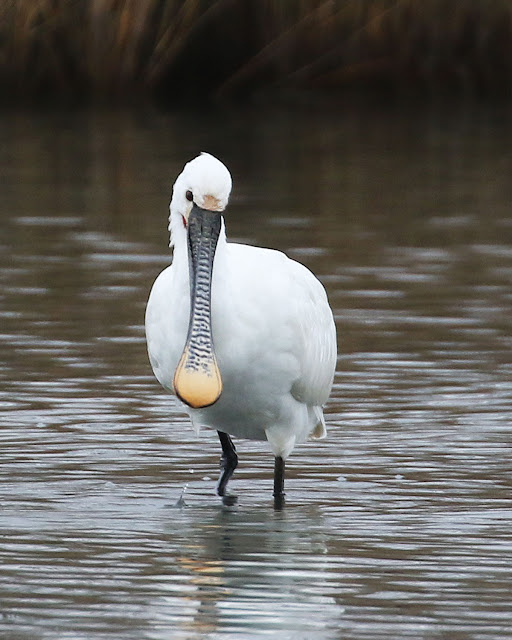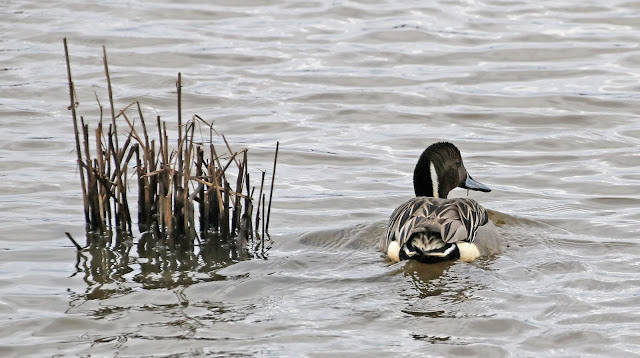It was a short drive from Cut Bridge around to the Keyhaven car park and from there we set off around the sea wall, the tide was now quite high and as we passed a field trip party they pointed out a rather distant Spoonbill on one of the islands. As we walked towards Keyhaven Lagoon we scanned for the Peregrine that are usually visible on the posts or other structures out on the marsh, but they were not to be seen.
Passing Keyhaven Lagoon, the Lapwing suddenly took to the air, nothing else went up so it was another case of nervy Lapwing. We were then left with black and white birds in the sky against the grey background.
A drake Pintail was close to the sea wall on the lagoon
While on the sea side there were Wigeon close in the drake reflecting nicely in the still rising water.
A Water Pipit had been reported in the flooded marshy area in the south east corner of the lagoon. A Pied Wagtail caught my attention, and then a pipit feeding around the grass tussocks.
The right place, but was it the right bird? At the time we thought so, back of the camera views showed a supercilium, but there was a nagging doubt over the lack of a clean appearance on the belly and more clarity on the streaking on the flanks. It was still not clear to me as I processed this image.
But once I saw the next two I knew we had seen a Rock Pipit, it has an olive grey appearance and the streaks continue down on to the belly and are blurred, almost smoky on the flanks.
The supercilium is well defined and there may be a case for this being of the sub species Littoralis, which breeds in Scandinavia and Russia, but I haven't explored it further.
Walking on to Fishtail, stayed on the low path and disturbed from the ground this male Reed Bunting.
Coming up on to the sea wall at Butts Bay there was an interesting view of the Needles, the cloud that was shrouding us was clearly broken away to the west and this was resulting in a pale orange hue behind the chalk stacks.
Walking towards the Jetty a Lesser Black-backed Gull flew directly towards us.
This species and the larger Great Black-backed regularly cruise the lagoons in search of an easy meal.
In the south eastern corner of the Jetty Lagoon were several pairs of Pintail.
This winter they seem to be more acceptable to remaining close, maybe there hasn't been so much wildfowling.
Past the Jetty and on to Pennington Lagoon there was the unusual sight of two snipe feeding along the edge of the lagoon under the bank.
Both together
While scanning the sea I came across the Slavonian Grebe that has been present this winter. It was a little closer than when I had last seen it two weeks ago.
I went through a period of preening and then into diving where it started to come closer, but only to move back away from us.
A small bird flew ahead of us over the gorse. We stopped and waited and could see it creeping through the branches, eventually it appeared at the top of the gorse and gave some really wonderful views with a lovely battleship grey background of the lagoon water as well.
First Views
Then showing really well
Looking closer it appears to have small crab spider
From the top of the gorse it flew to the middle of a Gorse bush close by.
Finally it moved back into the centre of the bush and we left it alone satisfied that we had enough images.
It wasn't the intention to walk too far, but after an encounter with a birder who said that there were feeding Spoonbill on Salterns we decided to walk on. As we crossed Oxey Creek at Moses Dock we could see the Spoonbill feeding in the Salterns lagoon.
There was one adult and two immature birds present.
The Spoonbill is almost
unmistakable in most of its range. The breeding bird is all white except for
its dark legs, black bill with a yellow tip, and a yellow breast patch like a pelican. It has a crest in the breeding season.
Non-breeders lack the crest and breast patch, and immature birds have a pale
bill and black tips to the primary flight feathers. Unlike herons, spoonbills
fly with their necks outstretched.
The diet consists of aquatic insects, molluscs, newts, crustaceans, worms, leeches, frogs, tadpoles and small fish up to 10–15 cm
long. It may also take algae or small fragments of aquatic plants (although
these are possibly ingested accidentally with animal matter). They use sideways sweeps of their beaks to
filter out the tiny fish and shrimps.
One of the the two immature birds had a white ring with a four digit code on the left leg, the code read "NC6U". I have requested information, from what I can understand it might be from a Dutch breeding colony, the bird was also reported at Brownsea Island last August.
Post Script: I have received details that this bird was ringed in the nest at Neeltje Jans, Inlaag Netherlands on the 10th June 2022. It was then seen two months later in Poole Harbour on the 10th August. Here are the details of its reported movements since then.
Then from what seemed nowhere a Spotted Redshank appeared, wading belly high in the water to join the feeding Spoonbill.
Back to the Spoonbill, the adult showing the breast patch well, there was though no sign yet of a crest.
An adult and immature standing together, you see the clear differences in the colouration of the bills, the adult black fading to a yellow ochre tip, while the immature bill is a pinky orange.
All three together, the ringed bird on the right.
You sit there waiting for the Spoonbill to throw up its catch and you wait for the picture, but after awhile you realise that you probably have what you need, for now anyway. I do have many photographs now of feeding Spoonbill.
We decided to head back, but as we passed the pool on the other side of the dock we found another Spotted Redshank feeding in the pool.
We headed back across Oxey Marsh to the sea wall and as we walked we could see two Spoonbill flying ahead of us. When we reached Pennington Lagoon they were feeding together, the adult and the ringed immature birds.
The Pintail were still present on Jetty Lagoon and I couldn't resist another photograph.
Then on Fishtail there was a good sized group of Tufted Duck, this one looking like it was at roost but was keeping a watchful eye open.
The sun was dropping in the sky, February means it was now setting around 17:00, quite a difference from the turn of the year, but the angle of light is still sufficient to create some glorious colour, these views across the flooded channels of Keyhaven Marsh now the tide was high.
A Wigeon silhouetted by the afternoon light against the water.
A drake Shoveler skimming the waters of Keyhaven lagoon.
On the sea side of the wall the Wigeon were still present, this drake looking decidedly smart.
We walked on heading back towards Keyhaven, these Brent passed through the sun lit distant clouds as they flew into the harbour.
Walking past the harbour bridge I always check the ropes and ladders that stretch out off the harbour wall at high tide for Kingfisher. There was nothing there, but as we passed the Milford Bird Observatory on the Avon Floods it was possible to see some of the strategically placed branches in front of the hide and sitting on one was in fact a Kingfisher.
It was the perfect end to what had been an excellent day. It was possible to focus the camera through the fence and hedge and with a little movement back a forth get some great shots.
The bill is all black which means this was a male bird.
Not sure if this was it calling or it had thrown a pellet.
Then it crouched low and immediately after this shot flew off calling across the water to the other side of the flood.
What a great day, the chance for Ian to catch up on the birds he had missed when away (maybe even overtake me once again), but also some wonderful photographic opportunities














































































No comments:
Post a Comment